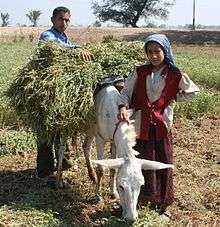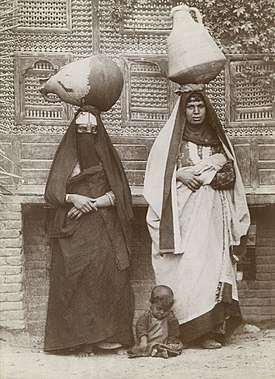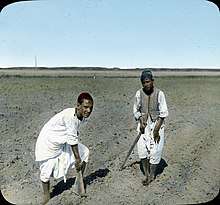Fellah
Fellah (Arabic: فلاح fallāḥ; feminine فَلَّاحَةٌ fallāḥatun; plural fellaheen or fellahin, فلاحين, fallāḥīn) is a farmer or agricultural laborer in the Middle East and North Africa. The word derives from the Arabic word for "ploughman" or "tiller".

Due to a continuity in beliefs and lifestyle with that of the Ancient Egyptians, the fellahin of Egypt have been described as the "true Egyptians".[1]
A fellah could be seen wearing a simple Egyptian cotton robe called galabieh (jellabiya). The word galabieh originated around 1715–25 and derived from the Egyptian slang word gallabīyah.
Origins and usage

Fellahin was the term used throughout the Middle East in the Ottoman period and later to refer to villagers and farmers.[2] Nur-eldeen Masalha translates it as "peasants".[3]
Fellahin were distinguished from the effendi (land-owning class),[4] although the fellahin in this region might be tenant farmers, smallholders, or live in a village that owned the land communally.[5][6] Others applied the term fellahin only to landless workers.[7] The term fallahin refers to non-Arabians, Kurds, Arameans, and Armenian villagers in the Middle East.[8] The term fallah was applied to people from several regions in the Middle East, including those of Egypt and Cyprus.
Fellahin in Egypt
When the Arabs conquered Egypt, they called the common peasant indigenous people (Copts) fellahin (peasants) due to their work in agriculture different from the Jews who were traders and the Greeks (Rum in Arabic) who were the ruling class . With the passage of time the name took on an ethnic character, when Egyptian Arab tribes call someone else fellah it is synonymous with "indigenous Egyptian" to some extent. Another thought is that when a Christian Egyptian converted to Islam he was called 'falih' which means winner or victorious, which means that he succeeded in abandoning Christianity and converting to Islam.
Note: Most of urban Egyptians are considered Fellahin too but they see the term fellahin as an offensive title so they prefer to call themselves Masriin (Egyptians) instead.
Comprising 60% of the Egyptian population,[9] the fellahin lead humble lives and continue to live in mud-brick houses like their ancient ancestors.[1] Their percentage was much higher in the early 20th century, before the large influx of Egyptian fellahin into urban towns and cities. In 1927, anthropologist Winifred Blackman, author of The Fellahin of Upper Egypt, conducted ethnographic research on the life of Upper Egyptian farmers and concluded that there were observable continuities between the cultural and religious beliefs and practices of the fellahin and those of ancient Egyptians.[10]
See also
- Bedouin, nomadic people from roughly the same region
References
| Wikimedia Commons has media related to Fellahs. |
- Pateman, Robert & Salwa El-Hamamsy (2003). Egypt. New York: Marshall Cavendish Benchmark. p. 54.
- Mahdi, Kamil A.; Würth, Anna; Lackner, Helen (2007). Yemen Into the Twenty-First Century: Continuity and Change. Garnet & Ithaca Press. p. 209.
- Masalha, Nur (2005). Catastrophe Remembered: Palestine, Israel and the Internal Refugees: Essays in Memory of Edward W. Said (1935-2003). Zed Books. p. 78.
- State Lands and Rural Development in mandatory Palestine, 1920–1948, Warwick P. N. Tyler, Sussex Academic Press, 2001, p. 13
- Hillel Cohen, Army of Shadows, Palestinian Collaboration with Zionism, 1917–1948, University of California Press, 2008, p. 32
- Healing the Land and the Nation: Malaria and the Zionist Project in Palestine, 1920–1947, Sandra Marlene Sufian, University of Chicago Press, 2007, p. 57
- Lords of the Lebanese Marches: Violence and Narrative in an Arab Society, Michael Gilsenan, I.B.Tauris, 2003, p. 13
- Smith, George Adam (1918). Syria and the Holy Land. George H. Doran company. p. 41.
fellahin syria.
- Who are the Fellahin? – Biot #312: December 24, 2005. SEMP, Inc.
- Faraldi, Caryll (11–17 May 2000). "A genius for hobnobbing". Al-Ahram Weekly. Archived from the original on 1 December 2017. Retrieved 30 November 2017.
